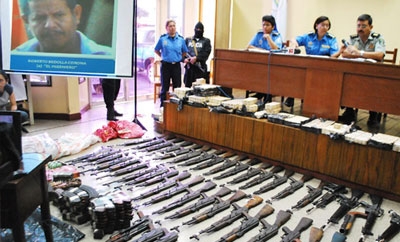Authorities in Nicaragua have identified the seizure of thousands of firearms over the past several years as the main reason for a large drop in the country’s homicide rate, but experiences around the region suggest the issue is unlikely to be so simple.
According to Nicaragua’s National Police, the seizure of 19,000 illegally owned firearms between 2008 and 2013 has played a critical role in reducing the country’s homicide rate from 11 homicides per 100,000 residents in 2012 to 8.7 homicides per 100,000 in 2013, reported El Nuevo Diario.
Nicaragua currently has the lowest homicide rate in Central America, followed by Costa Rica.
Nonetheless, officials from the arms control unit of the police (DAEM) said the majority of violent robberies in the country were not carried out with firearms, but rather, with weapons such as knives or machetes.
The low homicide rate does not mean the country is unaffected by violent crime, said Monica Zalaquett of NGO the Violence Prevention Center (CEPREV).
“There are a lot of robberies [in Nicaragua] using intimidation, in which firearms […] are generally used and many young people sustain bullet injuries,” she said.
InSight Crime Analysis
Compared to its Northern Triangle neighbors Guatemala, Honduras and El Salvador — which have some of the highest homicide rates in the world — Nicaragua remains relatively unaffected by gangs or organized crime-fueled violence. Last year, the United Nations Development Program (UNDP) placed Nicaragua among the six Latin American countries with the best citizen security indicators.
However, it is unlikely arms seizures have been the primary factor in maintaining low levels of violence. As InSight Crime has noted, there is little evidence that strict gun policies are a principal factor affecting murder rates in Latin America — ease of acquiring black market weapons, security force corruption and a strong organized crime presence all play an important role as well.
There are a number of other factors that have likely contributed to Nicaragua’s low — and falling — homicide rate. One often cited by authorities is the country’s unique community policing model, which has been credited with keeping out mara street gangs. Another possibility could be the tight social control exercised by the Sandinista government in many parts of the country.
SEE ALSO: Nicaragua News and Profiles
These ideas are supported by the fact that the country’s two Atlantic autonomous regions (the RAAN and RAAS) have murder rates far above the national average. These are the regions where the central government has the least control, and which have been most affected by the presence of transnational organized crime as both their remoteness and coastal location make them attractive stopover points for drug traffickers.

